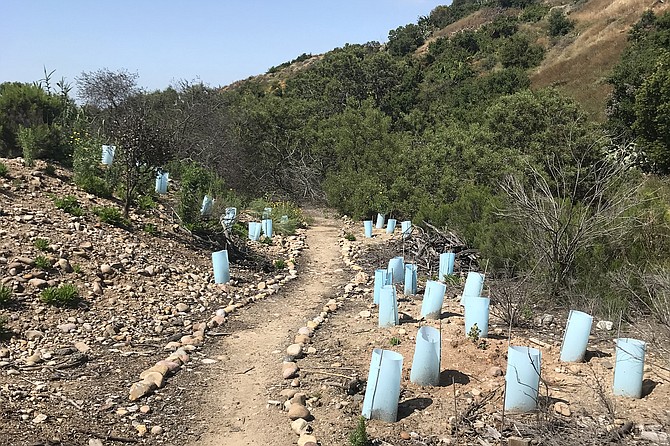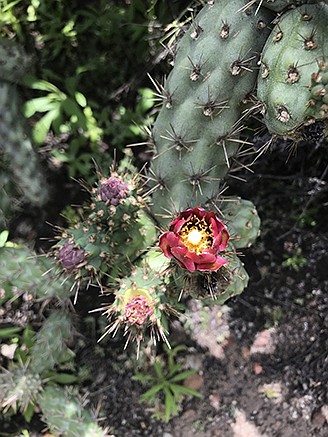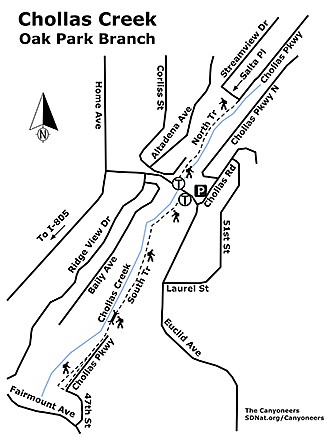 Facebook
Facebook
 X
X
 Instagram
Instagram
 TikTok
TikTok
 Youtube
Youtube

Chollas Creek runs through urban San Diego and is part of the Pueblo Watershed, running 32 miles from its headwaters in La Mesa and Lemon Grove to where it drains into San Diego Bay in Barrio Logan. The creek has four branches from its headwaters and runs through communities such as City Heights, Encanto, and Oak Park. The creek was a significant settlement for the Kumeyaay and provides multiple benefits to the region. Many nonprofits and organizations, including Groundwork San Diego-Chollas Creek and San Diego Canyonlands, have been working hard to restore and clean up the creek, improving trails and habitat.
This section of Chollas Creek runs through the community of Oak Park and is managed by the City of San Diego. There are trailheads at each end of this route, but the starting point for this hike is Euclid Avenue, taking the southern portion of the route, returning to the starting place, and then taking the northern portion of the route. Going south from Euclid Avenue is about a 1.75 mile out-and-back loop, and going north is about a 0.75 mile out-and-back loop.

At the trailhead on the southern side of Euclid Avenue, a few tall eucalyptus trees provide shade. As you make your way down the trail, you will find a variety of native plants, including flat-top buckwheat (Eriogonum fasciculatum) and chaparral mallow (Malacothamnus fasciculatus) boasting pink to purple flowers when blooming. You will then pass by a large stand of yerba santa (Eriodictyon crassifolium), which has fuzzy whitish-green leaves and purple flowers when in bloom. Soon you will reach a restoration site with a rock-lined path. You can find coast live oak trees (Quercus agrifolia) and other native plants that have recently been planted in this area in an effort to bring back native habitats. Continuing on the trail, you will see a healthy patch of southern honeysuckle (Lonicera subspicata) vining through shrubs and then entering a covered area under a huge, tree-like laurel sumac (Malosma laurina). Farther down the trail, look to your right to see the hillsides of the canyon that the creek runs through, side canyons, and signs of cliff erosion over time. If you look closely, you can even spot some chalk dudleya (Dudleya pulverulenta) on the hillside. Continuing on, you will find mulefat plants (Baccharis salicifolia), an indicator of the riparian habitat along the creek. You will soon cross a white bridge and the trail will come to parallel Chollas Parkway. Farther on, you will see the orange strands of the parasitic plant dodder (Cuscuta californica) covering many plants. While dodder does live off its host plants, it does not kill them. Continue on the path as it veers right and turns away from the road and the fence. Go west on the path and you will see a trail on your right. Turn down the trail and it will take you back to the main path, which will take you back to the start. This path is lined with broom baccharis (Baccharis sarothroides), San Diego sunflower (Bahiopsis laciniate) and California sunflower (Encelia californica), making it very colorful when in bloom.
Once back to where you started on Euclid Avenue, if you’d like to continue on, cross the street and head west on Euclid Avenue, crossing over the creek and walking up the hill. On the right-hand side, there will be a trailhead that you will turn down. Depending on the time of year, this trail can be overgrown, but it is easy to follow and there is some great habitat to be found in this section. If you’d like a less wild experience, you can parallel the creek on the east side, following a combination of trail and street paths.
The northern section of the trail features many of the same plants as the southern section, but there are some new varieties as well. You will find a few spiny redberry bushes (Rhamnus crocea) and a mature hollyleaf cherry tree (Prunus ilicifolia) right along the trail. On the hillside to your left, you will see a huge growth of coast cholla cactus (Cylindropuntia prolifera) with a few Mojave yucca plants (Yucca schidigera) below. Fields of tarweed (Madia sativa) can be seen and wild cucumber (Marah macrocarpa) winds through many plants. You will turn around on this trail once it reaches Chollas Parkway North, just south of Salta Place.
Throughout the walk, you can find all sorts of wildlife as well. Many bird species can be seen enjoying their native habitat, including scrub jays, mourning doves and Anna’s hummingbirds. Ravens and hawks can be seen and heard soaring overhead. During the spring, bees and butterflies are abundant and during the summer, lizards can be seen sunning themselves on the trail.
This route can be lengthened by continuing on the trails in either direction. These trails can also be linked to the City Heights Canyons Loop Trail system by hopping on Euclid Avenue, going west for 3 blocks, then following Euclid as it turns north for a block. The trailhead into Olivia (47th Street) Canyon will be on the west side of the street. This system includes Manzanita Canyon, Hollywood Canyon, and Swan Canyon.
The best time of year to visit the trail is in the cooler months of spring when the native plants are in bloom. There is not much shade on the trail so it’s best to avoid hot days and it is important to wear sun protection and bring water.

CHOLLAS CREEK (OAK PARK BRANCH)
Enjoy a creekside walk in urban San Diego.
Driving directions: From I-805, take the Home Avenue exit, go northeast on Home Avenue, continue on Home Avenue, turn right on to Euclid Avenue, follow this 0.3 mile until you reach Chollas Road. Residential parking near this intersection. Hiking length: 2.5 miles out-and-back, options to continue farther on trails from both ends of the route, or to link into canyon trails in the City Heights Canyons Loop Trail system for a much longer hike. Allow 1-1.5 hours. Difficulty: Easy. There area few spots where the trail narrows, but mostly it is flat with minimal elevation gain. No facilities.


Chollas Creek runs through urban San Diego and is part of the Pueblo Watershed, running 32 miles from its headwaters in La Mesa and Lemon Grove to where it drains into San Diego Bay in Barrio Logan. The creek has four branches from its headwaters and runs through communities such as City Heights, Encanto, and Oak Park. The creek was a significant settlement for the Kumeyaay and provides multiple benefits to the region. Many nonprofits and organizations, including Groundwork San Diego-Chollas Creek and San Diego Canyonlands, have been working hard to restore and clean up the creek, improving trails and habitat.
This section of Chollas Creek runs through the community of Oak Park and is managed by the City of San Diego. There are trailheads at each end of this route, but the starting point for this hike is Euclid Avenue, taking the southern portion of the route, returning to the starting place, and then taking the northern portion of the route. Going south from Euclid Avenue is about a 1.75 mile out-and-back loop, and going north is about a 0.75 mile out-and-back loop.

At the trailhead on the southern side of Euclid Avenue, a few tall eucalyptus trees provide shade. As you make your way down the trail, you will find a variety of native plants, including flat-top buckwheat (Eriogonum fasciculatum) and chaparral mallow (Malacothamnus fasciculatus) boasting pink to purple flowers when blooming. You will then pass by a large stand of yerba santa (Eriodictyon crassifolium), which has fuzzy whitish-green leaves and purple flowers when in bloom. Soon you will reach a restoration site with a rock-lined path. You can find coast live oak trees (Quercus agrifolia) and other native plants that have recently been planted in this area in an effort to bring back native habitats. Continuing on the trail, you will see a healthy patch of southern honeysuckle (Lonicera subspicata) vining through shrubs and then entering a covered area under a huge, tree-like laurel sumac (Malosma laurina). Farther down the trail, look to your right to see the hillsides of the canyon that the creek runs through, side canyons, and signs of cliff erosion over time. If you look closely, you can even spot some chalk dudleya (Dudleya pulverulenta) on the hillside. Continuing on, you will find mulefat plants (Baccharis salicifolia), an indicator of the riparian habitat along the creek. You will soon cross a white bridge and the trail will come to parallel Chollas Parkway. Farther on, you will see the orange strands of the parasitic plant dodder (Cuscuta californica) covering many plants. While dodder does live off its host plants, it does not kill them. Continue on the path as it veers right and turns away from the road and the fence. Go west on the path and you will see a trail on your right. Turn down the trail and it will take you back to the main path, which will take you back to the start. This path is lined with broom baccharis (Baccharis sarothroides), San Diego sunflower (Bahiopsis laciniate) and California sunflower (Encelia californica), making it very colorful when in bloom.
Once back to where you started on Euclid Avenue, if you’d like to continue on, cross the street and head west on Euclid Avenue, crossing over the creek and walking up the hill. On the right-hand side, there will be a trailhead that you will turn down. Depending on the time of year, this trail can be overgrown, but it is easy to follow and there is some great habitat to be found in this section. If you’d like a less wild experience, you can parallel the creek on the east side, following a combination of trail and street paths.
The northern section of the trail features many of the same plants as the southern section, but there are some new varieties as well. You will find a few spiny redberry bushes (Rhamnus crocea) and a mature hollyleaf cherry tree (Prunus ilicifolia) right along the trail. On the hillside to your left, you will see a huge growth of coast cholla cactus (Cylindropuntia prolifera) with a few Mojave yucca plants (Yucca schidigera) below. Fields of tarweed (Madia sativa) can be seen and wild cucumber (Marah macrocarpa) winds through many plants. You will turn around on this trail once it reaches Chollas Parkway North, just south of Salta Place.
Throughout the walk, you can find all sorts of wildlife as well. Many bird species can be seen enjoying their native habitat, including scrub jays, mourning doves and Anna’s hummingbirds. Ravens and hawks can be seen and heard soaring overhead. During the spring, bees and butterflies are abundant and during the summer, lizards can be seen sunning themselves on the trail.
This route can be lengthened by continuing on the trails in either direction. These trails can also be linked to the City Heights Canyons Loop Trail system by hopping on Euclid Avenue, going west for 3 blocks, then following Euclid as it turns north for a block. The trailhead into Olivia (47th Street) Canyon will be on the west side of the street. This system includes Manzanita Canyon, Hollywood Canyon, and Swan Canyon.
The best time of year to visit the trail is in the cooler months of spring when the native plants are in bloom. There is not much shade on the trail so it’s best to avoid hot days and it is important to wear sun protection and bring water.

CHOLLAS CREEK (OAK PARK BRANCH)
Enjoy a creekside walk in urban San Diego.
Driving directions: From I-805, take the Home Avenue exit, go northeast on Home Avenue, continue on Home Avenue, turn right on to Euclid Avenue, follow this 0.3 mile until you reach Chollas Road. Residential parking near this intersection. Hiking length: 2.5 miles out-and-back, options to continue farther on trails from both ends of the route, or to link into canyon trails in the City Heights Canyons Loop Trail system for a much longer hike. Allow 1-1.5 hours. Difficulty: Easy. There area few spots where the trail narrows, but mostly it is flat with minimal elevation gain. No facilities.
Comments